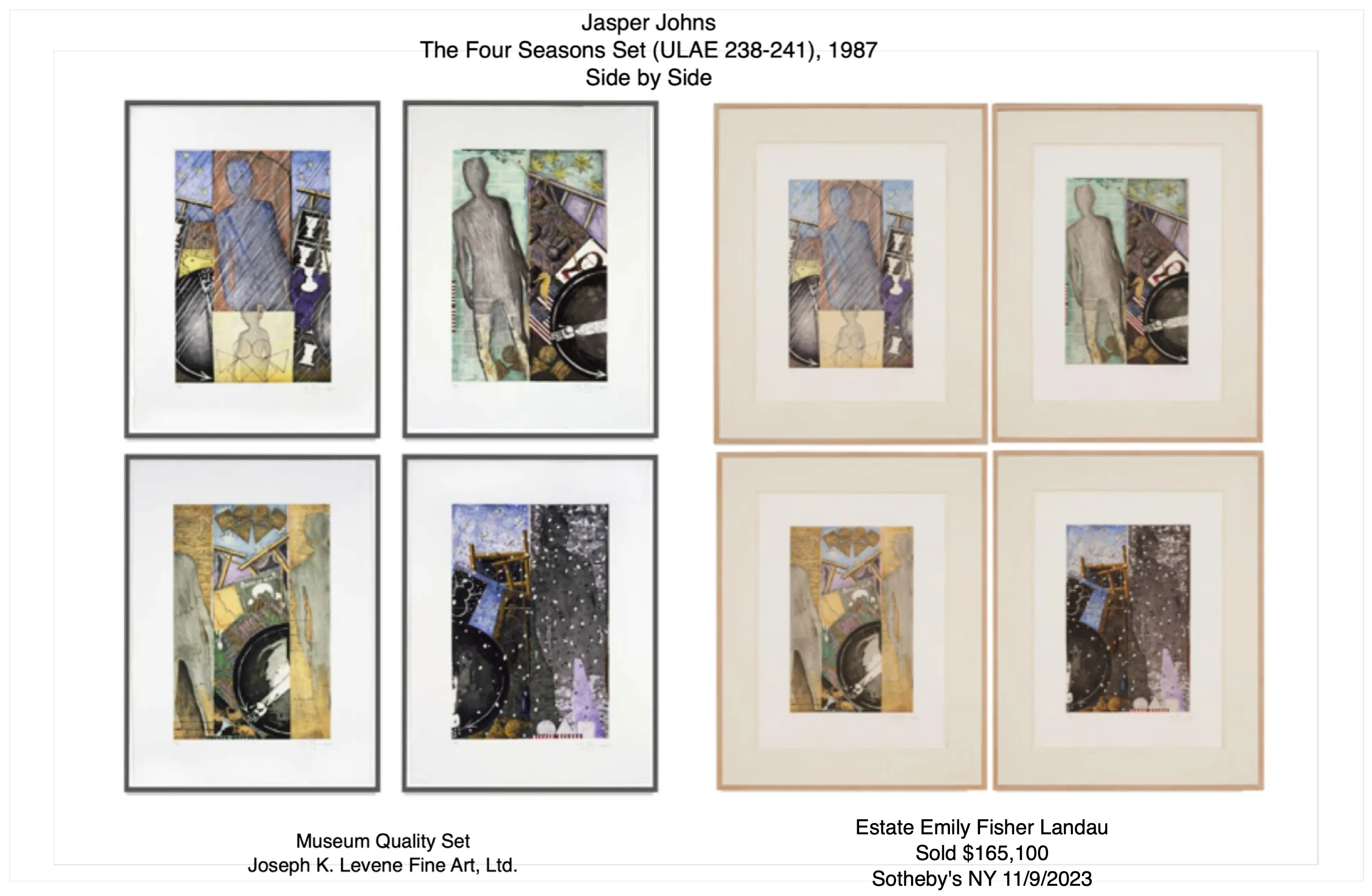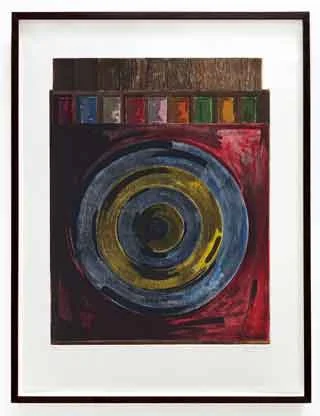(Spring, Summer, Fall, Winter) (ULAE 238-241), 1987
paper: 26 1/4 x 19 1/4 inches each
image: 19 x 12 3/4 inches each
frame: 28 x 21 inches each
edition: 73 with 16; 14; 14; 13 AP's respectively and 4 PP's
each signed & dated in pencil "J Johns '87" lower right
each numbered in pencil lower right
printed by John Lund, Hitoshi Kido, Craig Zammiello, Keith Brintzenhofe
published by Universal Limited Art Editions, 1987, with their blindstamp
© 2024 Jasper Johns / Licensed by VAGA at Artists Rights Society (ARS), NY
with exhibition labels from:
Brooke Alexander Editions, New York
Galería Weber, Alexander y Cobo, Madrid
Fundación Luis Cernuda, Seville; Casa de la Parra, Xunta, Santiago de Compostela
Fundació Pilar i Joan Miró a Mallorca, Palma de Mallorca
Cornell Fine Arts Museum, Rollins College, Winter Park, Florida
Provenance
Jasper Johns & Universal Limited Art Editions, New York
Brooke Alexander, Inc., New York
Literature
Mark Rosenthal, Jasper Johns: Works Since 1974, Philadelphia Museum of Art, Philadelphia, 1988, plate 33-36, pgs. 98-101, other impressions reproduced in color.
Elizabeth Armstrong, Jasper Johns: Printed Symbols, Walker Art Center, 1990, pgs. 78-82, another impression of each reproduced in full-page color.
Shigeo Chiba, Jasper Johns Prints Exhibition 1960–1989, Tokyo, 1990, Japan Art and Culture Association/Kokusai Geijutsu Bunka Shinkokai, n.p., plate 103-106, other impressions reproduced.
Roberta Bernstein, Jasper Johns: The Seasons, 1991, Brooke Alexander Editions, no. 13-16, pgs. 20-23, another impression of each reproduced in full-page color.
Michel Butor, Kathleen Slavin, Jasper Johns Gravures Dessins 1960-1991, Foundation Vincent Van Gogh, 1992, no. 72-75, pgs. 124-125, another impression of each reproduced in full-page color.
Richard Field, The Prints of Jasper Johns 1960-1993: A Catalogue Raisonne, ULAE, New York, 1994, Catalogue Reference ULAE 238-241, n.p.,another image of each reproduced in full-page color
Susan Lorence, Technique and Collaboration in the Prints of Jasper Johns, Castelli Gallery, New York, 1996, Catalogue Reference 35a-35d, p. 50-51, another impression of each reproduced in black and white
Joan Rothfuss, Past Things and Present: Jasper Johns since 1983, Walker Art Center, Minnesota, 2003, Catalogue Reference 14-17, pgs. 62-64, another impression of each reproduced in full-page color.
Iwona Blazwick, Jasper Johns: Shadow and Substance, Whitechapel Gallery, London, 2013, pgs. 18-21, another impression of each reproduced in full-page color.
Carlos Basualdo, Scott Rothkopf, Jasper Johns Mind/Mirror, The Whitney Museum of American Art, 2021, another impression reproduced plates 15, 21, 35, pgs. 291, 292, 295.
Exhibited
Philadelphia Museum of Art, Philadelphia, Jasper Johns: Works Since 1974, October 23, 1988-January 8, 1989, other impressions exhibited.
The Seibu Museum of Art, Tokyo, Prints Exhibition 1960–1989, Traveled to The Seibu Department Store, Isetan Museum of Art, Tokyo, April 26th—May 15th, 1990, Isetan Department Store, Niigata, June 7-19, 1990, Isetan Department Store, Urawa, July 18-24, 1990, Isetan Department Store, Matsudo, August 9—August 14, 1990, Isetan Department Store, Shizuoka, August 23—August 28, 1990, other impressions exhibited.
Walker Art Center, Minnesota, Jasper Johns: Printed Symbols, February 18-May 13, 1990, other impressions exhibited.
The Museum of Fine Arts, Houston, Jasper Johns: Printed Symbols, June 17-August 19, 1990, other impressions exhibited.
The Fine Arts Museums of San Francisco, San Francisco, Jasper Johns: Printed Symbols, September 15-November 18, 1990, other impressions exhibited.
Montreal Museum of Art, Montreal, Jasper Johns: Printed Symbols, December 14, 1990-March 10, 1991, other impressions exhibited.
Saint Louis Art Museum, St. Louis, Jasper Johns: Printed Symbols, April 6-May 27, 1991, other impressions exhibited.
Center for the Fine Arts, Miami, Jasper Johns: Printed Symbols, June 22-August 18, 1991, other impressions exhibited.
The Brooklyn Museum, Brooklyn, Jasper Johns: Printed Symbols, September 14-November 10, 1991, other impressions exhibited.
Brooke Alexander Editions, New York, Jasper Johns: The Seasons, Prints and Related Works, Nov. 9, 1991-Jan. 4, 1992, these impressions exhibited.
San Diego Museum of Art, California, Jasper Johns: The Seasons, Prints and Related Works, June 27-August 9, 1992, these impressions exhibited.
Galería Weber, Alexander y Cobo, Madrid, Jasper Johns: The Seasons, Prints and Related Works, Sept. 17-Nov. 14, 1992; Fundación Luis Cernuda, Seville; Casa de la Parra, Xunta, Santiago de Compostela; Fundació Pilar i Joan Miró a Mallorca, Palma de Mallorca, these impressions exhibited.
Stanford University Art Museum and T. W. Stanford Art Gallery, Stanford, California, The Anderson Print Collection at Stanford: Prints, Multiples and Monotypes 1968–1990, August 11 - December 13, 1992, other impressions exhibited.
Cornell Fine Arts Museum, Rollins College, Winter Park, Florida, Jasper Johns The Seasons, November 6, 1998-January 3, 1999, these impressions exhibited.
Fine Arts Museums of San Francisco, California Palace of the Legion of Honor, San Francisco, An American Focus: The Anderson Graphic Arts Collection, October 7, 2000 - December 31, 2000, other impressions exhibited.
Palm Springs Desert Museum, California, An American Focus: The Anderson Graphic Arts Collection, January 17-March 25, 2001, other impressions exhibited.
Gagosian Gallery, London, Jasper Johns: Prints From 1987-2001, April 24–June 7, 2003, other impressions exhibited.
Fine Arts Museum of San Francisco, M.H. de Young Memorial Museum, San Francisco, Jasper Johns: 45 Years of Master Prints, October 15, 2005 - February 12, 2006, other impressions exhibited.
The Museum of Modern Art, New York, Focus: Jasper Johns, December 5, 2008–February 16, 2009, other impressions exhibited.
The Phillips Collection, Washington, D.C., Jasper Johns Variations on a Theme, June 2-September 9, 2012, other impressions exhibited.
Halsey Institute of Contemporary Art, South Carolina, The Insistent Image: Recurrent Motifs in the Art of Shepard Fairey and Jasper Johns, May 22-July 12, 2014, other impressions exhibited.
Mattatuck Museum, Waterbury, Jasper Johns and John Lund: Masters in the Print Studio, February 6-May 10, 2015, other impressions exhibited.
Whitney Museum of American Art, New York, Jasper Johns: Mind/Mirror, October 28, 2021 - February 13, 2022, other impressions exhibited.
Selected Museum Collections
Walker Art Center, Minneapolis
Tate Modern, London
The National Gallery, Washington, DC
Powers Art Center, Aspen
Kemper Museum of Contemporary Art, Kansas City
The Los Angeles County Museum of Art, Los Angeles
The Museum of Modern Art, New York
Fisher Landau Center, New York
The Metropolitan Museum of Art, New York
The Whitney Museum of American Art, New York
Kempner Museum of Contemporary Art,, Kansas City
Philadelphia Museum of Art, Philadelphia












